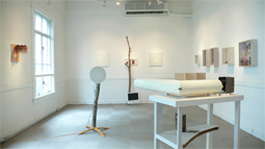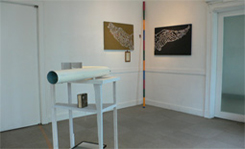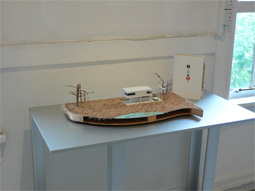 |
|
 |
| Installation view (2008) |
|
View of "Hata-hata" (2008)
Canvas, paper (lettering), collage, frame, paper (drypoint and embossed), resin (cherub), plastic lettering on pole
Left wing 1155 mm, right wing 1230 mm, height 2610 mm |
|
Yoshihisa Kitatsuji (b.1948, Osaka) emerged on the art scene in the Mono-ha (School of Things) era of the 1970s. In his early work he took monochrome photographs of the countryside, copied their contours through tracing paper, and gently dispersed the detailed image in favor of a skeleton schematic with the visual appeal of faintly imprinted memories. Kitatsuji's conceptual approach continued through the 1980s, but drew more from the field of sculpture, combining various media into constructions based upon mythical stories following a stay in Italy and culminating in a solo exhibition, "The Garden of Visitors" (2000), at The National Museum of Art, Osaka.
His most recent sculptural installation is "The Beginning of Autumn," a title also chosen for a collection of short stories recently penned by the artist -- his first. The seasonal reference coincides with the literal timing of the exhibition; the artist also acknowledges the metaphorical significance related to a certain sadness and the latter days of one's life. The title in black, running down the jacket cover, culminates in the final two hiragana script characters printed in red, impressing the seasonal turn.
The artworks are in many cases only tenuously related to the stories. Individual pieces were created at various stages following the genesis of the book, indicating a heuristic, cumulative process rather than the causal succession of book to artwork. Indeed, only in the instance of "The Large Woman in Red Clothes" (2008) does the artwork appear illustrative of the text, taking the same title. Rather than telescoping the story into a single immobile moment, the diorama appears more like a stage-set awaiting miniature characters to take their places. Here the white house of the French architect beloved by the woman of the story finds three-dimensional expression in a Le Corbusierian home with a toy car parked alongside it, leafless little trees and a body of water in front. As if to insist on the connection between book and artwork, standing to the side of the architectural model is a thick white tome titled "The Large Woman in Red Clothes." Elsewhere there is less cohesion between visual and narrative elements, though they continue to operate alongside or within each other.
In "Otoha" (2008), Kitatsuji departs from his own text, expanding on and interpreting that of another, writer Akiko Fujiwara. The work is composed of a series of wooden boxes mounted on the wall. Arranged inside are small objects -- like a paintbrush suspended at the top from which hangs a little clock connected by a string -- and quotations are inscribed throughout the constructions. The insides of the boxes are painted either figuratively or abstractly, and in one work a fine mesh wire fences in a collage of portraits in color and monochrome, organized around the central image of a landscape. These works have the thrust of little boxed collections of ideas that traverse back and forth between text and image. There appears to be a certain delicacy in this textual/visual relation for Kitatsuji, and found or selected objects -- such as the repeated draping of silver necklace chains throughout different works, or the shattered mirror of "Shiratama" (2008) -- suggest an overall fragility.
This word/image relationship finds further development in one corner of the gallery into which leans a long pole, segmented by thick stripes of bold color, "Hata-hata" (2008). The segmented color, however, is tape with imprinted hiragana script from a label writer, wrapped around the pole. What initially appeared to be entirely visual turns out to be verbal in origin. Beneath this a little kitsch cherub hangs on the wall, and flanking these are pictures of what appear at short distance to be wing patterns, echoing those of the cherub, but which on closer inspection are lines of text. These sentences appear as tributaries running off one another, and an order of reading is given by little digits that head up each sentence. The kanji characters and modifying hiragana script were scissored from magazines, arranged by Kitatsuji in their thousands, and then gradually assembled into branching configurations, one character at a time, as a processual method of arrangement.
The shifting back and forth between the legible and the visual is most prominent in the work "Moku" (2008), where clipped text is arranged into a spiral on a disk attached to a stripped-down electric fan. When this is turned on, the text becomes a swirling hypnotic vortex. The verbal component returns in the form of projected images shone through a section of plastic plumbing, casting kanji characters such as "snake" on the surface of the spinning disk.
The overall structure of the exhibition lacks the unification of a story. The gradual accretion of degrees of sense from the combination of fragments recalls the structure of Kitatsuji's short stories: unified by virtue of being brought together, but ultimately uncertain in the degrees of connection between the different components. Bringing the visual and verbal together has long been an artistic conundrum, and it is in this that the artist finds an attraction.
 |
|
 |
View of "Rira no ki no shita de" (2008)
Wood, drawing (panel pattern, wood, bronze), moving image, poem
2310 x 2275 x 410 mm |
|
View of "The Large Woman in Red Clothes" (2008)
Model (wood, glass, seed kernels, acrylic), book, collage |
|
|
|